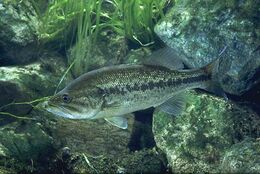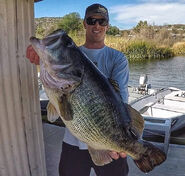
The largemouth bass (Micropterus salmoides) is a freshwater gamefish in the sunfish family, a species of black bass native to North America. It is known by a variety of regional names, such as the brown bass, widemouth bass, bigmouth bass, black bass, bucketmouth, Potter's fish, Florida bass, Florida largemouth, green bass, green trout, gilsdorf bass, linesides, Oswego bass, southern largemouth and (paradoxically) northern largemouth. The largemouth bass is the state fish of Alabama (official freshwater fish), Georgia, Mississippi, and Florida (state freshwater fish).
Description[]
The largemouth bass is an olive-green fish, in the North East right after ice-out, it most often has a gray color, marked by a series of dark, sometimes black, blotches forming a jagged horizontal stripe along each flank. The upper jaw (maxilla) of a largemouth bass extends beyond the rear margin of the orbit. In comparison to age, a female bass is larger than a male. The largemouth is the largest of the black basses, reaching a maximum recorded overall length of 29.5 in (75 cm) and a maximum unofficial weight of 25 pounds 1 ounce (11.4 kg). The fish lives 16 years on average (give or take a few years).
Feeding[]
The juvenile largemouth bass consumes mostly small bait fish, scuds, small shrimp, and insects. Adults consume smaller fish (bluegill, banded killifish), snails, crayfish, frogs, snakes, salamanders, bats and even small water birds, mammals, and baby alligators. In larger lakes and reservoirs, adult bass occupy deeper water than younger fish, and shift to a diet consisting almost entirely of smaller fish like shad, yellow perch, ciscoes, shiners, and sunfish. It also consumes younger members of larger fish species, such as pike, catfish, trout, walleye, white bass, striped bass, and even smaller black bass. Prey items can be as large as 50% of the bass's body length or larger.
Studies of prey utilization by largemouths show that in weedy waters, bass grow more slowly due to difficulty in acquiring prey. Less weed cover allows bass to more easily find and catch prey, but this consists of more open-water baitfish. With little or no cover, bass can devastate the prey population and starve or be stunted. Fisheries managers must consider these factors when designing regulations for specific bodies of water. Under overhead cover, such as overhanging banks, brush, or submerged structure, such as weedbeds, points, humps, ridges, and drop-offs, the largemouth bass uses its senses of hearing, sight, vibration, and smell to attack and seize its prey. Adult largemouth are generally apex predators within their habitat, but they are preyed upon by many animals while young.
Notably in the Great Lakes Region, Micropterus salmoides along with many other species of native fish have been known to prey upon the invasive round goby (Neogobius melanostomus). Remains of said fish have been found inside the stomachs of largemouth bass consistently. This feeding habit may impact the ecosystem positively, but more research must be conducted to verify this. Note that it is illegal to use Neogobius melanostomus as bait in the Great Lakes Region.
Angling[]
Largemouth bass are keenly sought after by anglers and are noted for the excitement of their fight. The fish will often become airborne in their effort to throw the hook, but many say that their cousin species, the smallmouth bass, can beat them pound for pound. Anglers most often fish for largemouth bass with lures such as plastic worms (and other plastic baits), jigs, crankbaitsand spinnerbaits. A recent trend is the use of large swimbaits to target trophy bass that often forage on juvenile rainbow trout in California. Fly fishing for largemouth bass may be done using both topwater and worm imitations tied with natural or synthetic materials. Live bait, such as nightcrawlers, minnows, frogs, or crawfish can also be productive. In fact, large golden shiners are a popular live bait used to catch trophy bass, especially when they are sluggish in the heat of summer or in the cold of winter. Largemouth bass usually hang around big patches of weeds and other shallow water cover. These fish are very capable of surviving in a wide variety of climates and waters. They are perhaps, one of North America's most tolerant fish.
The world record largemouth according to IGFA is shared by Manabu Kurita and George W. Perry, Kurita's bass was caught from Lake Biwa in Japan on July 2, 2009 and weighed 10.12 kg (22 lbs 4oz.) Perry's bass was caught June 2, 1932 from Montgomery Lake in Georgia and weighed 10.09 kg (22 lbs 4oz.) This record is shared because the IGFA states a new record must beat the old record by 2 ounces. Strong cultural pressure among largemouth bass anglers encourages the practice of catch and release, especially the larger specimens, mainly because larger specimens are usually breeding females that contribute heavily to future sport fishing stocks. Largemouth bass, if handled with care, respond well to catch and release. They have a white, slightly mushy meat, lower quality than that of the smallmouth bass, bluegill, yellow perch, crappie or walleye. Small largemouth, 10-14 inches, can be quite delicious when the water temperature is low but the large fish should be released.


